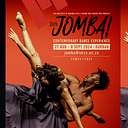Healing Aesthetics: Vincent Sekwati Mantsoe and Flatfoot Dance Company dance with “the unseen ones”
By Tammy Ballantyne (Guest Writer)
Cocooned from the world and its problems, the audience at the final performance of JOMBA! on September 10, journeyed with Flatfoot Dance Company and Vincent Sekwati Mantsoe into realms beyond ourselves, beyond the immediacy of our lives. Perhaps the gift of these two works — CUT (part 2) and KOMA — lies in the permission they give us to press pause; to practice patience and observation and ultimately to connect with deep energies that allow us to breathe out.
Mantsoe, honoured as the legacy artist for JOMBA! 2022, reaches a 30-year milestone in his rich dance and choreographic career. He has a strong bond with JOMBA! having premiered many of his works here and performing at its first edition in 1998. In addition to the showing of his short screen dance film, CUT (part 1), made during lockdown 2020, Mantsoe showcased his ongoing two-year process (2021 and 2022) with Flatfoot Dance Company in the offering of CUT (part 2). Embedded in the sharing and transmission of his legacy, Mantsoe took the company through his training system of GOBA — described by Mantsoe as “a philosophical and spiritual meditation”.
Evident in the work is the visceral connection with the earth. The seven dancers appear in evocative lighting, very still, heads raised. As the music draws us in through the sound of bells, cymbals and drums, the bodies fold and unfold. Palms are open, their gaze is considered, purposeful and we see Mantsoe’s grandmother in their postures — the GOBA meaning “bent” or “plié” — their chests close to the floor as we imagine her sweeping the yard in meaningful and repetitive strokes.
This image has stayed with Mantsoe since he was a child — the pigeons in his grandmother’s backyard were the genesis of his powerful and enigmatic solo Gula (1993, FNB Vita Dance Umbrella), which catapulted him into the minds and hearts of an international dance audience. Mentored and trained by Sylvia “Magogo” Glasser at Moving Into Dance, Mantsoe matured and built upon the Afrofusion legacy and technique into his now evolved spiritual channelling of his ancestors (a long line of Sangomas), accessing realms where he is seeking a gentler humanity.
The Flatfoot company’s energy takes us through bursts of staccato phrases, to moments of subdued, exhausted bodies strewn across the stage. The tempo of the music and breath are so important to the piece as we see heads thrown back, chests and arms wide, as they push forward, sweeping and reaching, looking and chasing, with Sifiso Khumalo a lone, despairing figure, reaching to grow the imbewu (seed) again.
CUT (part 2), a JOMBA! 2022 world premiere, is perhaps a way of bringing us back to ourselves after forced isolation; the stop/start of our dislocated lives; the importance of breath — breathing in and out, in and out.
In KOMA, Mantsoe dances with “the unseen ones”, works deeply with the ones we can feel, who inhabit the space as he dances. Cloaked by cloth and dim lighting to start, the almost-mystical figure enters the sacred arena as we are surrounded by a tapestry of music, voices, singing, drums, even violins washing over us. The transforming immersion that we witness as Mantsoe harnesses his inner life is by turns controlled and contorted; propelled by polyrhythms that shake and vibrate his body, we quiver with him as the sweat pours over him and the groans judder from a deep place within. We are drawn to his hands that offer a lightness, reminding us of his explorations into other cultures and dance practices such as Tai Chi. The climax is the unforgettable image of his wet body being engulfed by clouds of flour that billow and settle with each stamp.
After the storm has passed, Mantsoe returns gently to himself, gathers another cloth around his waist, calms the air as he sinks to his knees and crawls into the shaft of light, head bowed, forehead steadily pushing through the flour-exploded space as we quietly re-enter, transformed by our encounter with our own ancestors and spiritual voices.
Mantsoe’s KOMA is in his own words “ a painful and vulnerable journey” but one that is cleansing and purifying. At the end, the lone figure turns to his audience and in the weighty stillness and silence, he bows deeply, and thanks us for travelling with him through this healing process as he paid homage to those who have gone before him.
In this world of speed and mindless addictions to devices and social media, Mantsoe reminds us to water our imbewuand feed from within, to breathe into the past purposefully and take the long and quiet road to stillness.
